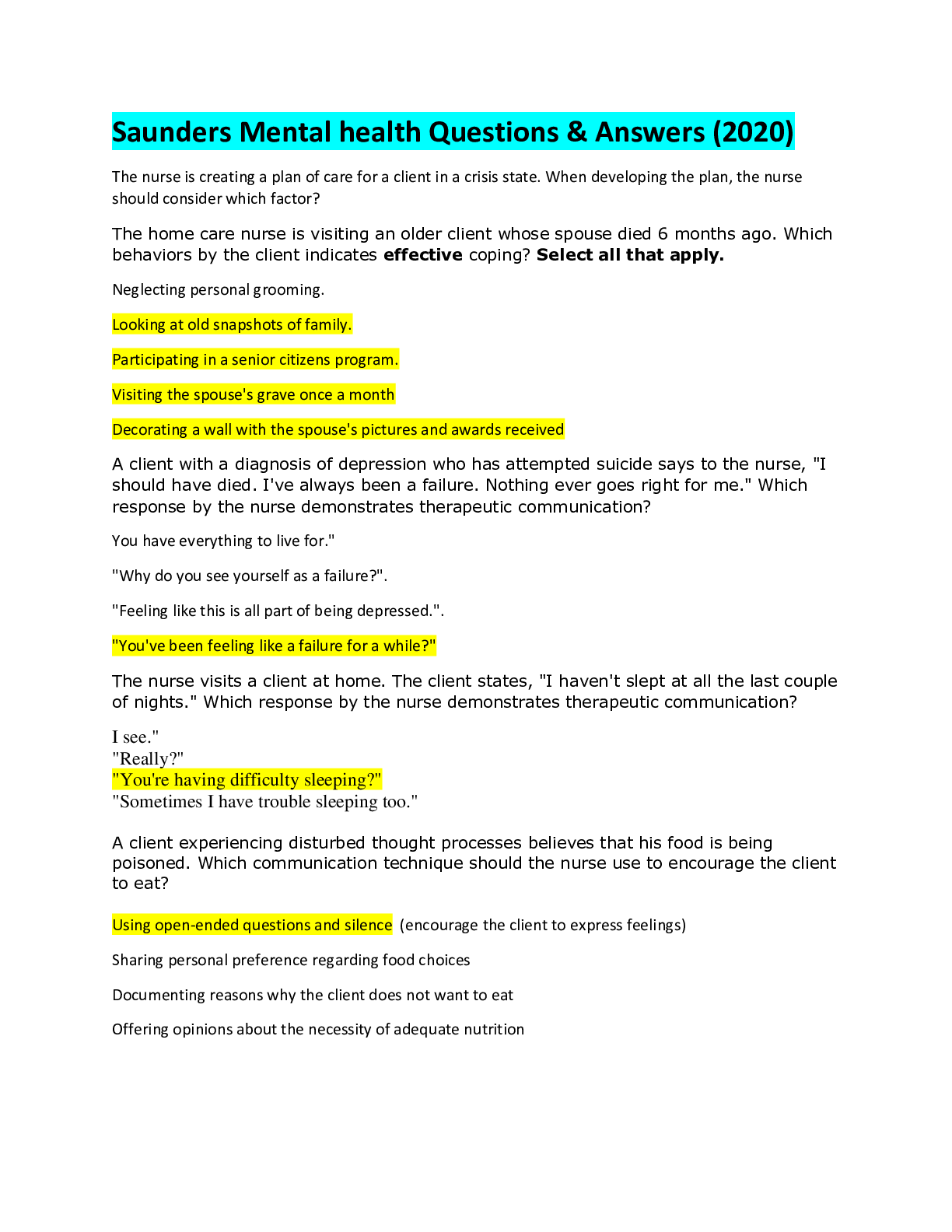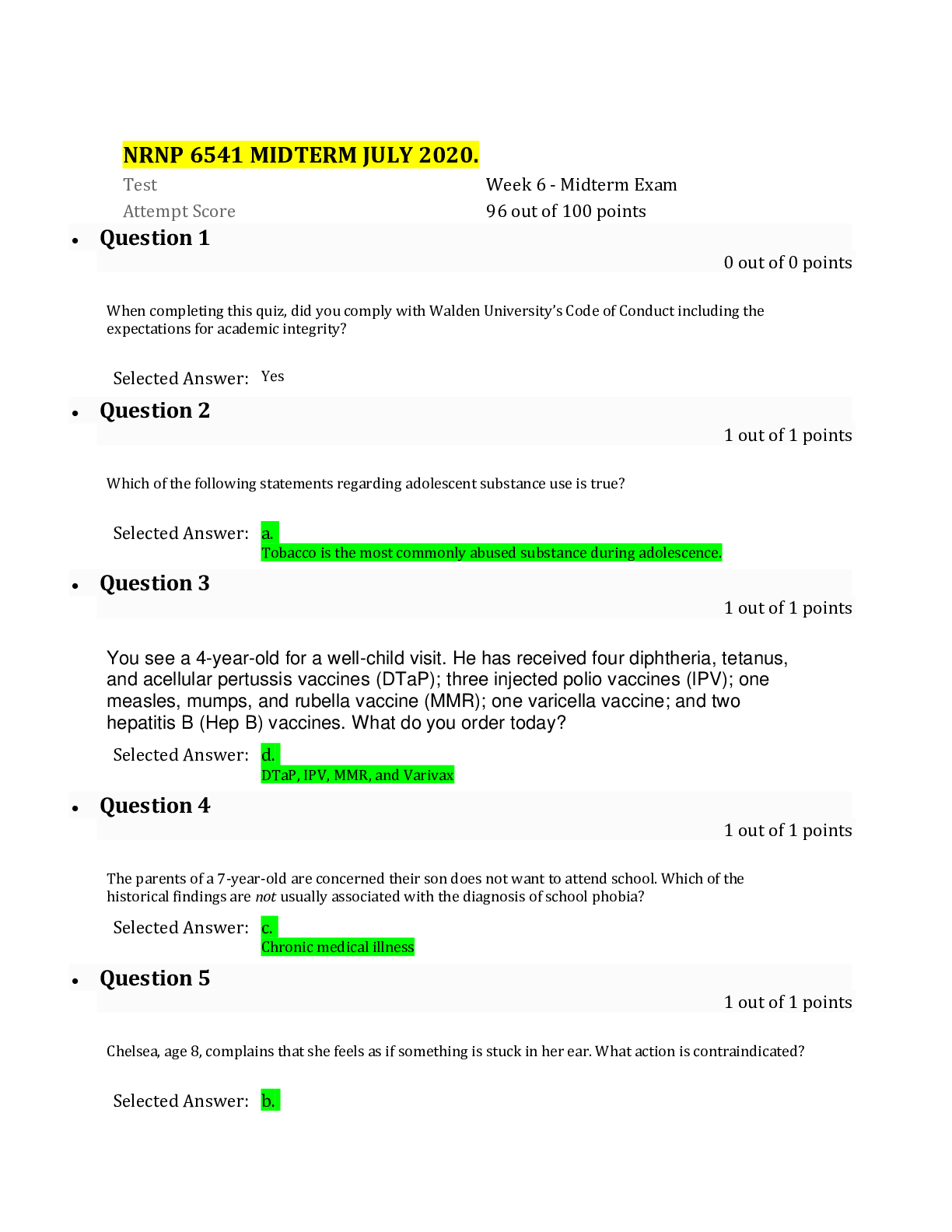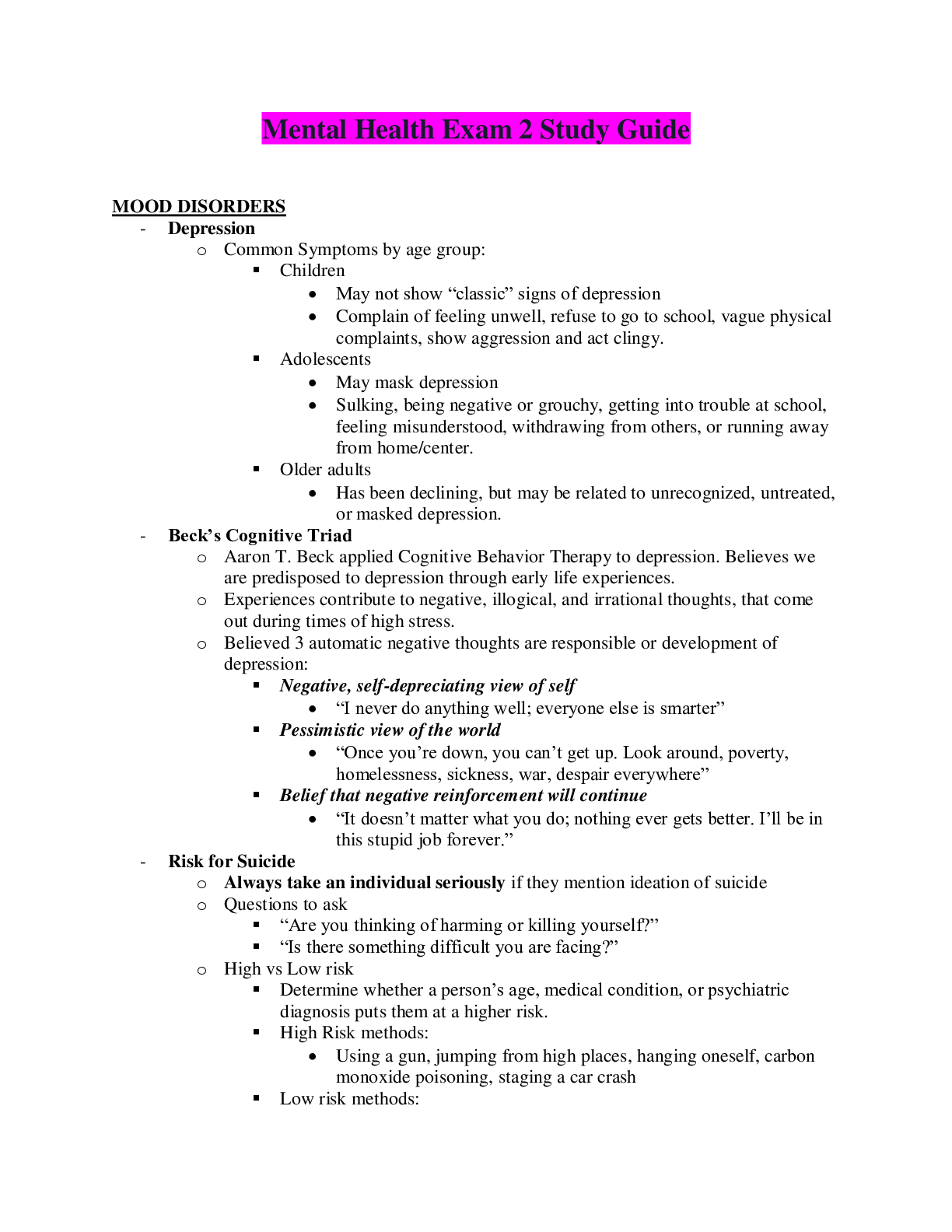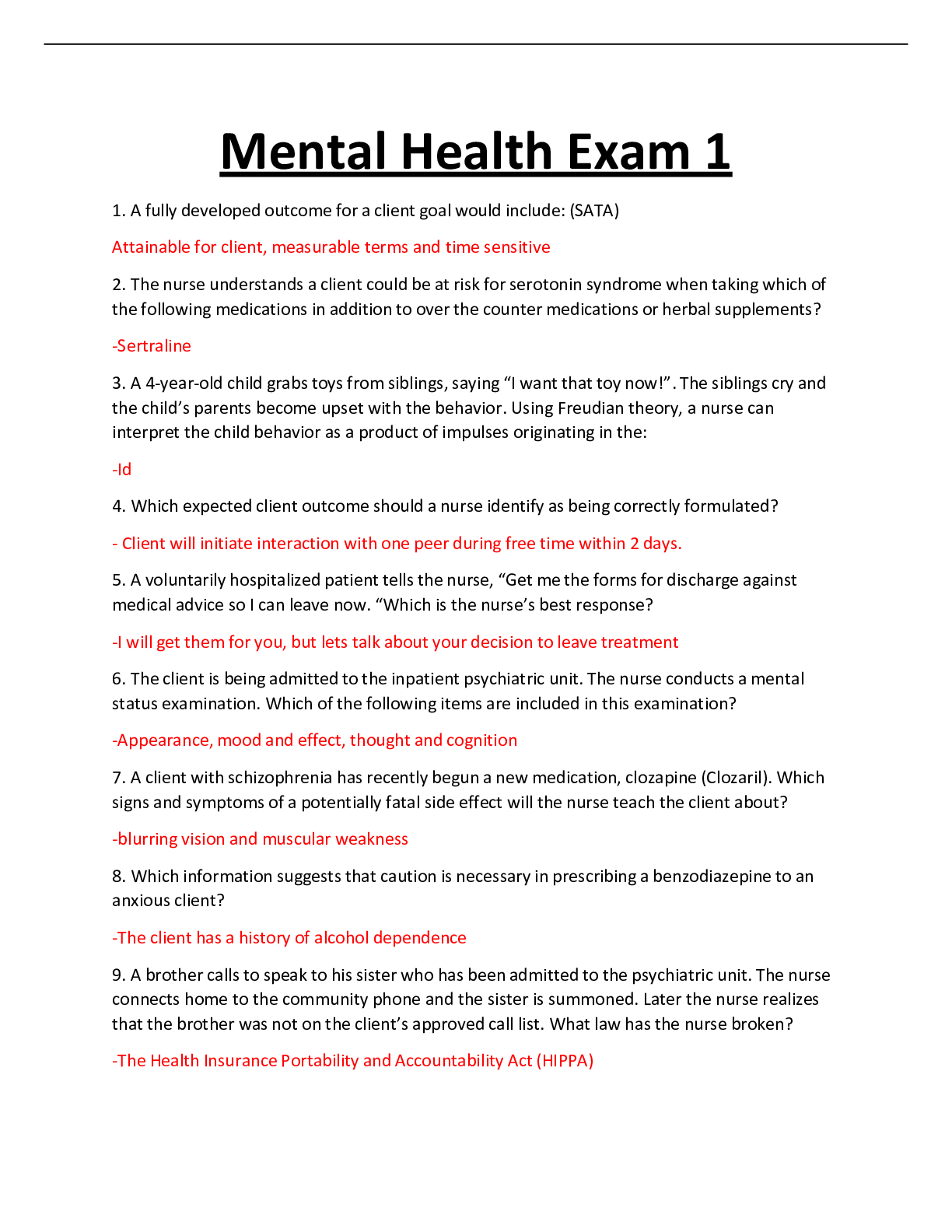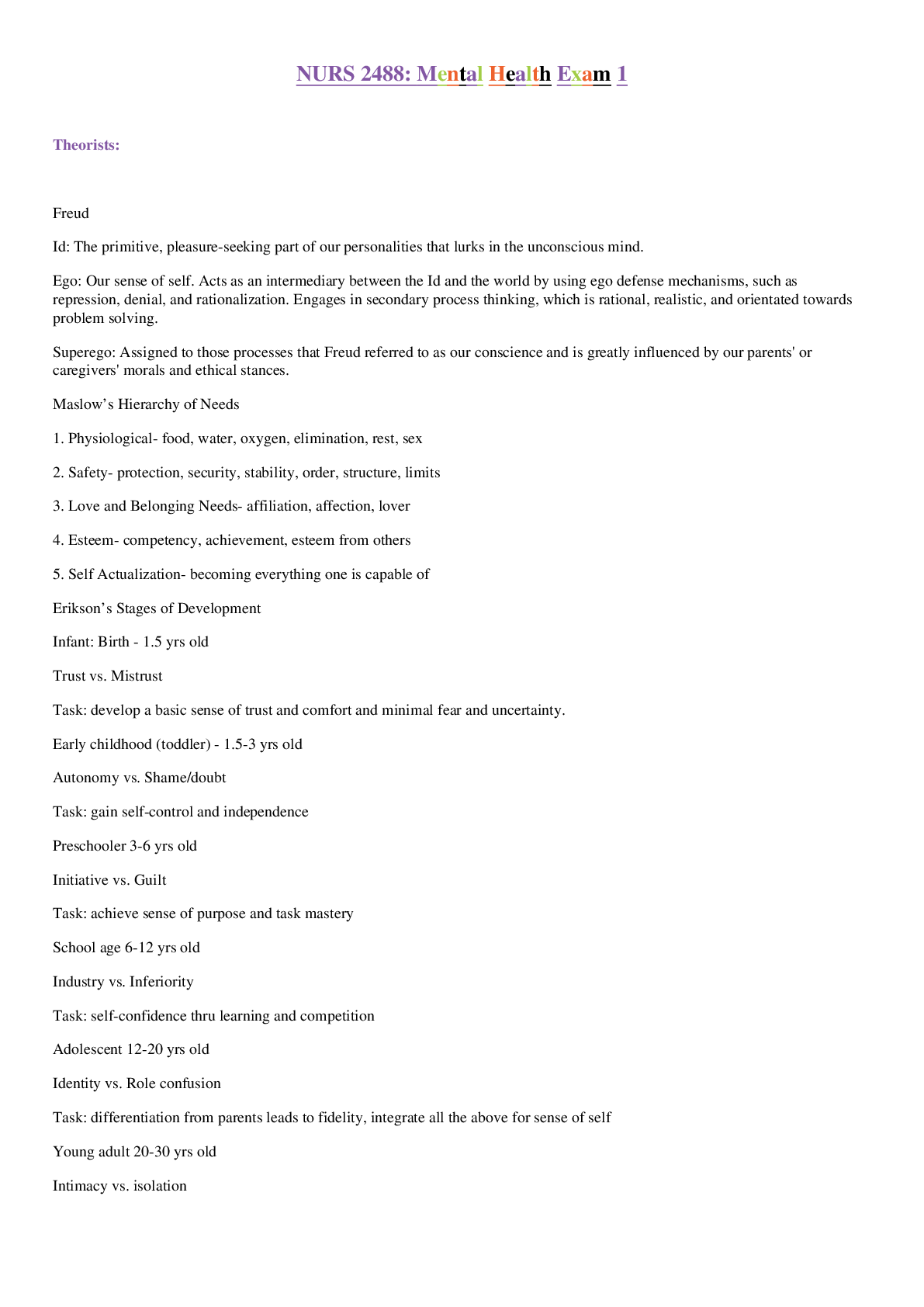ATI Proctored Mental Health Exam 2020 (100% Correct Answers)
Document Content and Description Below
ATI Proctored Mental Health 1. These are emotional issues or themes within a family that continue for atlas three generations such as a pattern of substance use or addictive behavior when the families... is under stress, dysfunctional grief pattern triangulation patterns and divorce - multigenerational issues 2. Believes that a force outside his body is controlling him - 3. believes that her thoughts are heard by others - 4. believes that his body is changing in an unusual way, scubas growing a third arm - 5. believes that others thoughts are being inserted into his mind - 6. Believes that she is all powerful and important like a god - 7. Believe that her thoughts have been removed from her mind by an outside agency - 8. Blaming others for unacceptable thoughts and feelings Ex: a young adult planes his substance use disorder on his parent’s refusal to buy him a new car - 9. The body's response to an increased demand. The first stage is initial adaptive response aka fight or flight mechanism. If it is prolonged maladaptive responses can occur - 10. Characterized by arrogance, grandiose views of self-importance, the need for consistent admiration and a lack of empathy for others that strains most relationships; often sensitive to criticism - 11. Characterized by disregard for others with exploitation, repeated unlawful actions, deceit, and failure to accept personal responsibility - 12. Characterized by distrust and suspiciousness toward others based on unfounded beliefs that others want to harm, exploit, or deceive the person - 13. characterized by emotional attention-seeking behavior in which the person needs to be the center of attention often seductive and flirtations - 14. Characterized by emotional detachment, disinterest in close relationships and indifference to praise or criticism; often uncooperative - 15. Characterized by extreme dependency in a close relationship with a n urgent search to find a replacement when one relationship ends - 16. Characterized by instability of affect, identity, and relationships, as well as splitting behaviors, manipulations, impulsiveness, and fear of abandonment; often tries self-injury - 17. Characterized by odd beliefs leading to interpersonal difficulties, an eccentric appearance, and magical thinking or perceptual distortions that are not clear delusions or hallucinations - 18. Characterized by perfectionism with a focus on orderliness and control to the extent that the individual may not be able to accomplish a given task - 19. Characterized by social inhibition and avoidance of all situations that rear interpersonal contact, despite wanting close relationships due to extreme fear of rejection; often very anxious in social situations - 20. The client experiences delusional timing for atlas 1 month. Self or interpersonal function is not markedly impaired - 21. The client experiences psychosis within 1 month of substance intoxication or withdrawal. May be caused by medications intend for therapeutic use - 22. The client has atlas 2 years of repeated hypomanic manifestations that do not meet the criteria for hypomania episodes alternating with minor depressive episodes. - 23. the client has at least one episode of mania alternating with major depression - 24. the client has impairments of personality functioning. However, impairment is not as severe as with schizophrenia - 25. The client has manifestation similar to those of schizophrenia, the but duration is from 1 to 6 months and social occupation dysfunction may or may not be present - 26. The client has one or more hypomanic episodes alternating with major depressive episodes - 27. the client has psychotic manifestations that last between 1 day to 1 month in duration - 28. The client has psychotic thinking or behavior present for atlas 6 months. Areas of functions including school or work, self-care, and interpersonal realties are significantly impaired - 29. The client may say sentence after sentence but each sentence may relate to another topic and the listener is bale to follow the client’s thoughts - 30. The client receives positive rewards for positive behavior positive reinforcement - 31. the clients disorder meets both the criteria for schizophrenia and depressive or bipolar disorder - 32. clients who have dependent and histrionic personality disorders often benefit from - 33. Clients who have schizoid or schizotypal personality disorders ten to - 34. complications of TMS - 35. complications of VNS - 36. creating reasonable and acceptable explanations for unacceptable behavior Ex: A young adult explains he had to drive home from a party after drinking alcohol because he had to feed his dog. - 37. Dealing with anxiety by reaching out to others. Ex: a nurse who lost a family member in a fire is a volunteer firefighter - 38. Dealing with unacceptable feelings or impulses by unconsciously substitute acceptable forms of expression. Ex: a person who has feelings of anger and hostility toward his work supervisor sublimates those feelings by working out vigorously at the gym during his lunch period - 39. demonstrating an inability to reconcile negative and positive attributes of self or others Ex: a client tells a nurse that she is the only one who cares about her, yet the following day the same client refuses to talk to the nurse - 40. Electrical stimulus time vs seizure time - 41. exposing a client while in the company of a therapist to a great deal of an undesirable stimulus in an attempt to turn off the anxiety response - 42. Feels singled out for harm by others (being hunted down by FBI) - 43. the group process progresses without any attempt by the leader to control the direction - 44. High risk pt with ECT - 45. Initial phase of group development includes: - 46. is obsessed with religious beliefs - 47. The leader completely controls the direction and structure of the group without allowing group interaction or decision making to solve problems - 48. Made up words that have meaning only to the client such as i tranged and flitted. - 49. May feel that her spouse is sexually involved with another individual - 50. a member of the family with little power is blamed for problems within the family - 51. Misconstrues trivial events and attaches personal significance to them, such as believing that others, who are discussing the next meal, are talking about them - 52. one member takes responsibility for problems to keep peace at all costs - 53. Orientation phase of a therapeutic relationship includes what? - 54. Overcompensating or demonstrating the opposite behavior of what is felt. Ex: a person who dislikes her sister’s daughter offers to babysit so that her sister can go out of town - 55. Pairing of a maladaptive behavior with a punishment or unpleasant stimuli such as a bitter taste or mild electric shock as punishment for behaviors such as alcohol use disorder violence self-mutilation and thumb sucking - 56. Performing an act to make up for prior behavior. Ex; An adolescent completes his chores without being prompted to after having an argument with his parents. - 57. pretending the truth is no reality to manage the anxiety of acknowledging what is real. Ex: A parent who is informed that his son was killed in combat tells everyone he is coming home for the holidays. - 58. preventing a client from performing a compulsive behavior with the intent that anxiety will diminish - 59. Putting unacceptable ideas, thoughts, and emotions out of conscious awareness. Ex: a person who has a fear of the dentist's drill continually "forgets" his dental appointments. - 60. Risk factors for neurocognitive disorder and Alzheimer's disease - 61. risk factors for cognitive disorders - 62. Risk factors of Bipolar - 63. Shifting feelings related to an object, person, or situation to another less threatening object, person, or situation Ex: A person who is angry about losing his job destroys his child's favorite toy - 64. some group members or the leader may have goals different from the stated group goals that may disrupt group processes - 65. SSRI - 66. Standardized screening tools for cognitive disorders - 67. teaching a client, when negative thoughts or compulsive behaviors arise, to say or shout, "stop" and substitute a positive thought. this goal over time is for the client to use the command silently - 68. temporarily blocking memories and perceptions from consciousness Ex: an adolescent witness a shooting and is unable to recall any details of the vent - 69. Termination phase of a therapeutic relationship includes what? - 70. Termination phase of group development includes: - 71. A therapist or others serve as a role models for a client, who imitates this modeling to improve behavior - 72. a third party is drawn into the relationship with two members whose relationship is unstable - 73. This style supports group interacting and decision making to solve problems - 74. This therapy is the planned, progressive, or graduate exposure to anxiety providing stimuli in relief situation, or by imagining events that case anxiety during exposure the client uses relaxation - 75. This therapy uses various techniques to control pain tension and anxiety - 76. Voluntarily denying unpleasant thoughts and feelings. Ex: A person who has lost his job states he will worry about paying his bills next week - 77. What antidepressants are prescribed for psychotic disorders - - 78. What are affective symptoms - 79. What are cognitive symptoms of psychotic disorders - 80. What are healthy defense mechanisms? - 81. What are immature defenses - 82. what are intermediate defenses - 83. What are the adverse effects of neurocognitive disorder medications? - 84. What are the anxiolytics/ bento's used for psychotic disorders? - -s 85. What are the atypical anxiolytic? - 86. What are the common pathological personality characteristics in a personality disorder? - 87. What are the conventional antipsychotics for psychotic disorders? - 88. What are the fight or flight responses or adaptive responses? - 89. What are the medications for anxiety disorder (Benzo)? - 90. What are the personality disorders in cluster A? - 91. What are the personality disorders in Cluster B? - 92. What are the prolonged stress or maladaptive responses? - 93. What are the risk factors of personality disorders? - 94. What are the standardized screening tools for Bipolar disorders? - 95. What are the standardized screen tools for depressive disorders? - 96. What are the standardized screen tools for psychotic disorders? - 97. What Atypical antidepressants are used for depression? - 98. What atypical antipsychotics would be prescribed for patients with psychotic disorders? - 99. What client teaching is needed with a depressive patient that is taking atypical antidepressants - 100. What client teaching is needed with a depressive patient that is taking SNRI's - 101. What client teaching is needed with a depressive patient when they are taking TCA? - 102. What client teaching is need with a depressive patient taking MAOI's - 103. What is dialectical behavior therapy used on what type of patient - 104. What is ECT not successful in? - 105. What is included in cognitive reframing? - 106. What is injected before ECT to decrease secretions and counteract any vagal stimulation? - 107. What is the first line of treatment for anxiety disorders? - 108. What MAOI's are used for depression - 109. What medications are given for patients that have bipolar disorder? - 110. What medications maybe used for personality disorders - 111. What medications would you give for a patient that has a neurocognitive disorder - 112. What medications would you give for a patient that has Delirium - 113. What meds should be discontinued before ECT - 114. What muscle relaxant is used - 115. What personality disorders are in cluster C - 116. What screen tools do you use for Stress management? - l 117. what short acting anesthetic is used for ECT - 118. What SNRI's are used for depression? - 119. What SSRI's are used for depression? - 120. What standardized screen tools would be used for anxiety disorders? - 121. What TCA's are used for depression? - 122. When patient is taking SSRI for depression what client teaching needs to be done? - 123. who can ECT be used on? - 124. Working phase of a therapeutic relationship includes what? - 125. Working phase of group development includes: - [Show More]
Last updated: 2 years ago
Preview 1 out of 38 pages
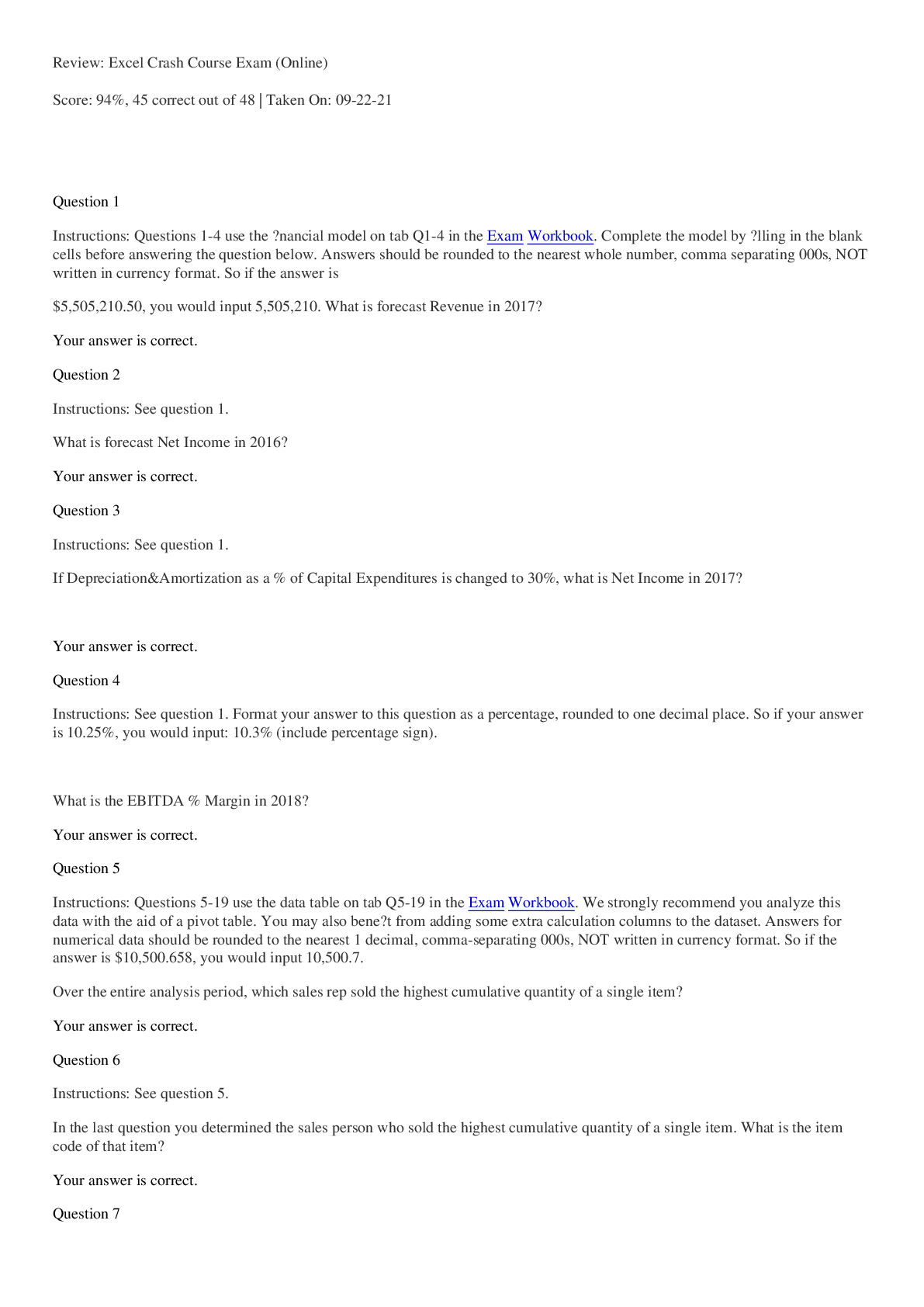
Buy this document to get the full access instantly
Instant Download Access after purchase
Buy NowInstant download
We Accept:

Reviews( 0 )
$16.00
Can't find what you want? Try our AI powered Search
Document information
Connected school, study & course
About the document
Uploaded On
Mar 29, 2021
Number of pages
38
Written in
Additional information
This document has been written for:
Uploaded
Mar 29, 2021
Downloads
0
Views
116













